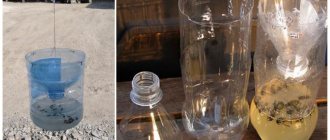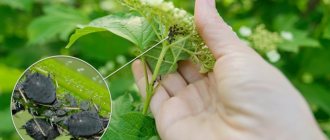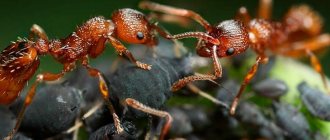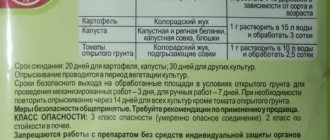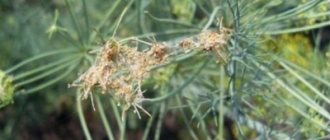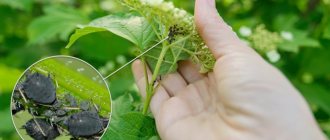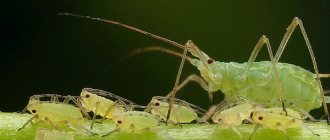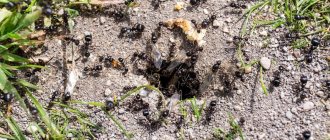Many gardeners who decide to grow grapes on their plots expect to receive a bountiful harvest of sweet berries. And in the process of their ripening, admire the beauty of the grapes filling with juice and the picturesque shoots climbing the walls of the buildings. Unfortunately, the problem of pest control often gets in the way of achieving the desired result. One of the most dangerous and tenacious enemies of this crop is the aphid on grapes, also called phylloxera.
This rapidly reproducing and voracious insect did not leave North America until a certain point. Until in the 19th century it was introduced to Europe and other continents as far as Australia and New Zealand.
A real invasion began, devastating European vineyards. Because the varieties cultivated there were not resistant to this type of pest.
Aphids have also penetrated into Russia, settling in the southern regions where grapes are traditionally grown. At the moment, the vineyards of the Crimean Peninsula, Rostov region, Caucasus, Stavropol, Krasnodar Territory are under threat of aphid invasion.
The fight against aphids on grapes causes a lot of trouble for gardeners. It is necessary to take measures to destroy aphids as early as possible. Better yet, take care of preventative treatment of the vineyard in advance.
This article will talk about how to protect grape bushes from aphid attacks and how to defeat them if an infection does occur.
Why are aphids dangerous?
The main danger of aphids for grapes is their abundance and gluttony. Pests attack the vines en masse, practically clinging to the plant. They especially “like” the tops of shoots, young leaves, buds and fruit ovaries.
Pests suck the juice out of the plant, depriving it of essential nutrients. They “inject” an enzyme into the tissue that “inhibits” photosynthesis and other natural processes. It gradually accumulates, having a depressing effect on the grapes. The vine's immunity deteriorates, and the risk of infection with fungal diseases increases. If nothing is done, the grapes wither and the yield is greatly reduced. As a result, the plant dies.
Provided with a “food source”, aphids begin to actively reproduce, the number of individuals on the grapes quickly increases
Preventative work
In order not to look for a way to destroy phylloxera in vineyards, it is better to take time to attend to methods of its prevention. Individual recommendations are considered working. It is advisable to do the following:
- comply with quarantine conditions for new plants - keep them at a distance and process them before planting;
- in the spring, carry out three treatments using professional insecticides or traditional methods;
- choose varieties that are resistant to aphid attacks;
- use rootstock;
- it is enough to deepen the root system;
- choose suitable soil for planting.
Following these rules does not guarantee the absence of a problem 100% of the time, so you should regularly inspect your plants in order to detect signs of a problem early. Mineral fertilizers help reduce the risk of infection; they must be applied according to a special schedule.
Description and photo of aphids
The “appearance” of aphids depends on the species. Several varieties of aphids attack grapes.
Root (phylloxera)
These insects go “outside” extremely rarely; they feed on the juice sucked from the roots of the grapes. The color is yellowish-beige or dark brown, with symmetrical black-brown dots on the back.
Root aphids reproduce very actively, one female lays up to 800 eggs per day
Winged (galled)
It attacks the above-ground part of the plant, feeding on the juice of shoots, leaves, flowers, and fruits. The outer chitinous shells are bright, orange-red, the main color is greenish-yellow or beige. In females, the rudiments of wings are visible on the sides of the body. Aphid larvae, hatching from eggs laid by females, gradually “descend” down to the roots of the grapes.
Adult individuals that have survived 3-4 moults “gain” wings and actively move, striking neighboring vines and other plants in the garden
Sexual
All individuals are wingless, the color is light green or almost transparent. Their lifespan is only eight days, during which time the female manages to lay a single egg that can successfully overwinter under the bark.
Sexual aphids settle under the bark of a plant
Important! Aphid eggs are almost indistinguishable to the naked eye; the presence of clutches is indicated only by “swellings” on the leaves of the grapes.
Any aphid is a very small insect (maximum 1-1.5 mm in length). Her body is ovoid, with three pairs of limbs and a “proboscis”. The period of activity practically coincides with the growing season for most plants - from mid-May to early November.
Pests
Insects wait out the cold in fallen leaves and thickened plantings. Pests in single quantities will not harm the grapes. However, they multiply quickly and will destroy the bush without treatment. Affected trees become weakened and are susceptible to diseases.
The most dangerous harmful insects:
- Phylloxera is a microscopic insect that somewhat resembles a dark aphid. It lives on the surface of the earth, sucks juice from the rhizome, which provokes the development of bacteriosis and fungus. The pest is difficult to exterminate, so protection is essential.
- The marbled beetle is a large beetle (up to 3 cm) of a dark brown color. Particularly dangerous are the larvae that infect roots up to 300 cm.
- Leaf rollers are caterpillars that eat buds and berries. Insect damage can be determined by the cobwebs on young shoots of a tree.
- The grape moth is a greenish-blue flying insect that breeds in high humidity. Pest larvae eat buds and leaves.
- Cicadas are jumping butterflies that feed on plant sap. This provokes weakening and spread of viral and fungal infections. In just one season, the pest can destroy all the crops in the garden. Settles in plant remains and thickened plantings.
- Spider mites are microscopic insects. Almost impossible to see with the naked eye. The pest sucks sap from young branches and leaves. Active life begins in dry weather, with a lack of moisture. Affected trees shed their leaves and dry out. Spider mites can be identified by the thin web between leaves, clusters, and flat plaques on the underside of the plates.
- Wasps - pollinate during the flowering period, but become pests towards the end. They feed on berries, which interferes with picking and spoils the fruit.
- Slugs and snails eat greens and impair photosynthesis. Appears when there is excessive humidity.
It can be quite difficult to exterminate these pests. In most cases, it is necessary to use poisonous drugs, which is not very good for the fruit tree.
Causes
Most often, aphids attack grapes because the gardener neglects preventive measures aimed at preventing the pest from attacking. Also increasing the chances of its attack on the vines is non-compliance with the planting scheme, choosing a location for the vineyard without taking into account the most important criteria for the plant (quality and composition of the substrate, lighting). Another risk factor is neglect of grape care and gross mistakes in agricultural technology.
Aphids are extremely “omnivorous” insects. It affects the vast majority of garden crops. Therefore, it can be argued that, having appeared on the site, sooner or later she will “get” to the grapes.
Crop protection methods
Methods of protection against raids depend on several factors: the location of the garden, the birds that live in the area of the summer cottage, and your ability to create protective equipment. Among all the ways to protect sweet bunches, there are 2 types:
- Isolation of grapes.
- Scaring off robbers in the following ways: optical, visual,
- sound,
- combined.
Before scaring off thieves, professionals advise placing several drinking bowls at your summer cottage. Perhaps the small birds, who only want to quench their thirst, will drink from the drinking bowls and not touch the vineyard. The water in containers must be clean and fresh. It needs to be changed every day.
Signs of infection
It is quite difficult not to notice aphids on grapes. There are a lot of numbers against her.
"Secondary" symptoms:
- sticky sweetish coating on the surface of the leaves;
- numerous areas of tissue discolored almost to the point of transparency;
- the surface of the leaf plates, covered with spherical “growths”;
- twisted, deformed leaves, buds, fruit ovaries, shoots.
In severe cases, if the gardener does not pay attention to aphids on grapes, leaves, flowers and buds dry out and fall off en masse, and the formation and ripening of fruits stops. Young shoots also dry out and die. The bush is affected by a variety of fungal diseases.
The main sign of aphids on grapes is “galls” on the leaves containing clutches of eggs.
Types of parasites
In nature, there are more than 4 thousand varieties of aphids, about 1 thousand species live in our area. Each species chooses its own crop, but with a significant increase in the number of insects, they move to any plant, tree, or bush. Ants facilitate the movement of aphids throughout the garden area. They feed on honeydew, which leaves small insects on the leaves, so ants choose the juiciest, most delicious plants for aphids.
The most common pest of vineyards is gall or green aphids. Initially, the insect parasitizes in the lower part of the root system and gradually moves to the leaves. Cold, rainy weather can stop the proliferation of pests. In other cases, the female continuously lays eggs, from which larvae - small bugs - appear within 10 days.
Aphids are noticeable due to their large numbers. The size of one individual does not exceed 1 mm. Body color is yellow-brown, green, brownish to match the leaves of the grape. The insect settles on the underside of young leaves. Growths are also found there - galls with eggs. The body of the aphid is oblong, ovoid, with 3 pairs of limbs. Eggs are less than 1 mm, oval in shape, yellow-green in color. A photo of grape aphids is located below.
With severe infection, the leaves fall off, the inflorescences crumble, and the fruits stop forming. Young shoots die off, the bush begins to hurt. If proper measures are not taken, the plant may die. The insect parasitizes throughout the warm season - it starts at the end of May and ends at the beginning of November. Overwinters in the egg stage on the roots, under the bark.
Aphids on grapes
How it spreads
Aphids can spread either passively or actively. In the first case, it can get on the grapes in the following ways:
- Planting seedlings already infected with the pest.
- Transport by wind.
- "Help" from a gardener. Aphids can end up in the soil, on agricultural implements and tools, work gloves and clothing.
- "Invasion" by ants. They specifically transfer its eggs to the most “juicy” and “tasty” plants.
- Transfer by water flows (during irrigation, during rain). Water can “knock” aphids to the ground, where they die, but sometimes in this way the insects “move” to neighboring plants.
For ants, aphids are a kind of “milch animal”: they feed on the sweetish honeydew that it leaves on the leaves
Adult winged individuals independently “migrate” between plants. Aphids that live underground move much more slowly, but they are also capable of “crawling” from one root system to another.
Fighting methods
When deciding how to treat phylloxera, you need to consider the extent of the lesion. If the problem is local, it is easier to remove several seedlings. In case of massive but not extensive damage, it is advisable to use professional insecticidal preparations and traditional methods or use them in combination.
A radical method is to remove infected bushes. They must be uprooted, the roots removed and all plant residue burned. You can plant new bushes in the same place no earlier than 5 years later. After the removal procedure, processing by any of the methods is considered mandatory.
Insecticide treatment
In case of mass damage, three-time treatment with insecticidal preparations is used in the following periods:
- in the first ten days of May for the middle zone (approximate dates for other regions are determined depending on the growth phase; at least 2 leaves should appear on it);
- at the end of May, when more than 10 leaves appear on the plant;
- after 1 month, when the greens have fully opened.
When affected by leaf phylloxera, the following drugs are used:
- "Zolon";
- "Aktellik";
- "Marshal";
- "Inta-vir";
- "Confidor";
- "Karate";
- "Spark";
- "Kinmiks."
If there is damage to the root system, it is permissible to use carbon disulfide.
The drugs are used in doses specified in the instructions for use. Solutions cannot be kept ready-made; they are used immediately. Before work, you need to protect your skin and protect yourself from inhaling caustic substances using a respirator.
Traditional methods
Folk methods of combating phylloxera are used very rarely, especially as independent remedies. Insufficient prevalence is associated with low efficiency. Most often they are considered as disease prevention, but are not chosen for treatment.
The first treatment is carried out in the spring, after the risk of return frosts has been eliminated. Plantings are sprayed with a solution of iron sulfate from a spray bottle at the rate of 300 g of product per 10 liters of water. To eliminate root damage, use a solution with a higher concentration - 500 g per 10 liters of water. Make a hole 20 cm deep near the bush and pour the solution into it. After the liquid is absorbed, the depression is filled with soil.
How to get rid of aphids on grapes
The range of products for controlling aphids on grapes is very wide. For prevention and in the early stages of disease development, folk remedies or preparations of biological origin are used. When insects have already multiplied in numbers, only insecticide chemicals will help.
In addition, we must not forget about safety for human health, pets, and the environment. Many anti-aphid drugs negatively affect the quality of grapes - chemicals accumulate in the berries. Therefore, they can only be used during certain periods of vine development. One of the main taboos is to spray grapes with insecticides during flowering.
Important! Grapes severely affected by aphids should not be spared. Such vines, along with the root system, are removed from the garden bed and burned; the soil must be disinfected.
Insecticides destroy adults, less often larvae, but they are useless against eggs, so several treatments are required
Chemicals
The chemicals “poison” the grape vines, making them inedible to aphids. Feeding on the sap of such plants, pests die almost instantly. The effect of the treatment lasts up to 20 days.
Fastak
Synthetic universal insecticide with contact-gastric action. It is valued by gardeners for its economy, resistance to precipitation, and safety for insects pollinating grapes.
Fastak against aphids can be used “in combination” with other insecticides and fungicides
Fozalon
Contact-intestinal insecticide. It begins to act instantly and retains the effect for at least 20 days. Its effectiveness is not affected by rain and low temperatures.
Fozalon against aphids is easily “identified” by its characteristic garlic odor
Kinmiks
A nerve agent that destroys different types and forms (adults, larvae) of aphids on grapes. To completely cope with the pest, 1-2 treatments are enough.
The manufacturer declares the possibility of using Kinmiks against aphids during the entire period of active grape growing season
Aktellik
One of the most effective, but at the same time very toxic to humans, animals, birds, and other insects, is an insecticide of contact-intestinal and systemic action. When working with it, it is necessary to use personal protective equipment for the eyes and respiratory system. You also need to wear gloves and closed clothing, shoes to prevent the solution from coming into contact with the skin.
The use of Actellik eliminates the repeated attack of aphids on treated grape vines this season
Important! You can spray grapes with insecticides against aphids either in early spring (before flowering) or in late autumn. In emergency cases, treatment is allowed during the active growing season, if there are at least 20 days left before harvest.
Biological agents
Biological preparations can be used to treat grapes against aphids even during flowering and ripening of the berries. But they give the desired effect 5-10 days after treatment; it lasts for a maximum of two weeks.
Fitoverm
Effective against aphids, thrips and spider mites. The result is provided by a natural neurotoxin. It enters the body of aphids through the skin or intestines, and therefore affects only adult individuals.
Grapes can be eaten 48 hours after treatment with Fitoverm against aphids
Iskra-Bio
Suitable for controlling aphids not only on grapes, but also on any other plants in the garden. The “peak” effect is observed 3-5 days after spraying; grapes can be eaten after 2-3 days.
Iskra-Bio operates through biopesticides that paralyze aphids
Biotlin
The active substance against aphids is bitoxybacillin. The drug is quickly absorbed by tissues, pests die after three days. The effect of the treatment lasts for 20 days (if it is dry outside and the temperature does not rise above 30 °C).
After ten days, re-spraying with Biotlin against aphids is mandatory.
Another biological method of pest control on grapes involves the “help” of entomophages. Predatory insects - natural enemies of aphids - destroy adults, larvae, and egg laying.
Insectivorous birds - warblers, wrens, tits, and robins - are useful in the fight against aphids on grapes. They are attracted to the site by installing “houses,” drinking bowls, and feeders. But there is always a risk that the birds will “switch” to the crops grown by the gardener.
Treatment of grapes against aphids with folk remedies
To combat aphids on grapes, experienced gardeners suggest using:
- Laundry or green potassium soap. Approximately 50 g of shavings are whipped into foam and diluted in 10 liters of water. Soap can be added in small quantities to other solutions so that they “stick” to the grapes better.
- Tomato or potato tops. Fresh “raw materials” (500-600 g) are crushed and boiled in 10 liters of water over low heat for about an hour. The finished liquid is filtered and diluted 1:1 with water. Similarly, you can use the greens of any plants with a pungent odor (wormwood, tansy, marigold, celandine).
- Wood ash. To combat aphids on grapes, it can be used in “dry form”, sprinkling the soil and dusting the plants. You can add ground pepper and tobacco crumbs to the ash. An infusion is also prepared by pouring boiling water (3 l) over the ash (0.5 l) and infusing for 3-4 hours.
- Onion or garlic “arrows” (heads will also do). Approximately 150 g of greens are finely chopped, poured with a liter of water, and left for 5-7 days. Then filter, pour the liquid into a bucket (10 l) of water.
- Table (9%) vinegar. Working solution – 200 ml of vinegar per 10 liters of water. You can use ammonia - 10 ml per 10 liters.
The effectiveness of most folk remedies is due to the fact that aphids are repelled by strong odors.
Folk remedies are absolutely safe for human health and the environment; they are suitable for treating grapes against aphids in the summer. However, their effect is short-lived (maximum 7-10 days, usually until the first rain).
Mechanical methods
The simplest mechanical method of combating aphids on grapes is to “knock them down” to the ground with jets of water. You need to pour water on the vines from a hose, ensuring a sufficiently strong pressure. Once on the ground, aphids can no longer “climb up” back; they quickly become prey to natural enemies - insects and birds.
Important! The method is not universal; it is not suitable for grape varieties with thin leaves. In addition, strong water pressure can damage buds, flowers, and fruit ovaries.
It is necessary to water the bushes once every 2-3 days until the pest completely disappears.
An “auxiliary” method of combating aphids on grapes is pruning. It is necessary to immediately remove all parts of the vine (leaves, shoots, flowers) on which pests are noticed. Since aphids attack vines en masse, literally clinging to them, it is impossible to collect them manually.
The procedure for spring processing of grapes, rules for using drugs
Usually grapes are covered for the winter. In the spring, when the temperature stabilizes, the tree is gradually opened and the branches are tied up. After the shelter is completely removed, preparations for the upcoming season begin:
- After wintering (in central Russia - April 1-15, in the south - in March), treat with fungicides. After a couple of weeks, the manipulations are repeated.
- The second spraying is carried out in the second half of May, before flowering. Insecticides against insects and fungicides against diseases are used. If the tree has been affected by parasites, the treatment must be repeated after 10-12 days.
- The last spraying is carried out after flowering with contact insecticidal preparations and fungicides.
During the formation of buds, processing is prohibited. During the summer, treatment measures are carried out when lesions are detected. In autumn, final processing is carried out after the greenery has fallen.
Prevention
It is easier to prevent aphids from attacking grapes than to later deal with the consequences of infection. Simple preventive measures will help minimize the risk of insect attacks on vines:
- Planting grapes in a suitable substrate - sandy. If the soil is not light and loose enough, the immunity of the vines suffers, and in this state they are more susceptible to attacks by pests, including aphids.
- Regular (at least once every 5-7 days) thorough inspection of the vines. It allows you to detect aphids on grapes immediately after their appearance, and not when the insect has already multiplied en masse.
- Immediate pruning of parts of the vine affected by aphids. The resulting plant waste cannot be stored; it is burned as quickly as possible.
- Annual digging or deep loosening of the soil under the grapes at the end of the growing season. The beds are first cleared of plant debris (fallen leaves, rotten berries, broken branches). Thus, the gardener destroys places suitable for overwintering eggs and larvae of the pest. Also, as part of treating grapes against aphids in spring and late autumn, the soil is spilled with hot water and sprinkled with wood ash.
- Planting herbs or ornamental plants with a pungent odor next to the grapes (mint, lemon balm, lavender, sage, wormwood, marigolds). Aphids do not like such “aromas”; they quite effectively repel insects from the vines.
- Fighting ants. They live in a stable symbiosis with aphids. If there are anthills near the grapes, the vines will almost certainly have a pest.
- Pre-planting treatment of grape seedling roots. They are soaked for 15-20 minutes in a solution of any insecticide suitable for controlling aphids.
Competent agricultural technology for grapes is a “universal” preventive measure that reduces the risk of developing infections and aphid attacks
When to process grapes in spring: timing of spraying
The first spring treatment of grapes is recommended in early spring, followed by continued preventive spraying as the vine develops. To spray the plant, 7 periods per season are distinguished.
Blooming grapes attract many pests
Therapeutic and preventive treatments of the vine are carried out during:
- enlargement of buds after gartering a plant freed from shelter;
- the appearance of the first leaves;
- budding, before the plant can open its inflorescences;
- the berries reach the size of a pea;
- shortly before picking berries;
- in the fall after harvest.
Some summer residents and gardeners process grapes during flowering, but it is not advisable to use strong products. Even prevention using folk methods may be enough to scare away or harm the insects pollinating the plant.
Of the listed treatments, the first three occur in the spring.
Reviews
I use ash in early spring and fall. This is not a problem for me, since I have a stove for heating in my house. I am very pleased with the result. It’s July now, the bunches of grapes are hanging beautifully, the leaves are not affected by any pests.
Next to the grapes I plant mint, dill and tansy. The smell repels aphids, and attracts ladybugs; they successfully cope with their task - they devour these pests.
I make an infusion of horseradish. I grind its root and leaves, fill a 20-liter container to a third and fill it with water. You need to mix well and let it brew for 2-3 hours. After this, you can spray the grapes.
Resistant varieties
For many years, breeders conducted research in which thousands of seedlings were tested. , varieties resistant to phyllosphere were identified
- Muscat Bessarabian;
- Krasnostop AZOS;
- Anniversary of Moldova;
- Vierul-59;
- Kubanets;
- Starting;
- Jubilee Magaracha;
- Risus;
- Golodriga Ruby;
- Muscat Livadia and others.
Reference! Tempranillo is the most susceptible variety to phylloxera.
Grape phylloxera is a very dangerous insect. Every winegrower should know how to detect and manage this disease. Remember that the key to a healthy vineyard, a rich harvest and your peace of mind is prevention against grape aphids. These measures will protect the plantings not only from phylloxera, but also from various diseases caused by fungi or other pests.
Precautionary measures
Working with insecticides in the garden is dangerous for humans, so you must first protect yourself from exposure to chemicals.
Spraying of vineyards is carried out in calm weather, after rain. Protective agents make the foliage vulnerable, so treat the bushes in the evening to avoid burns. Before the procedure, put on personal protective equipment - a mask or respirator, goggles, gloves. Cover all areas of your body, otherwise an allergic reaction may occur.
Spraying solutions are prepared before treatment, but not in advance. Follow the proportions recommended by the manufacturer.
Marble Khrushchev
Unlike the May beetle, the marbled beetle has a spotted coloration of the elytra (white patches on a brown background). The danger is posed by beetle larvae - large, up to 5-7 cm, whitish-dirty in color with a dark head. They parasitize on the roots of bushes, destroying grape plantings of any age.
The life cycle of beetles is long, and if in the first year the larvae are not dangerous to plants, then from the second year they begin their invasions, destroying seedlings, roots, and young shoots.
Fighting methods:
- preventive etching of soil using Decis, Aktara, Aktellik;
- introducing granular insecticides into the soil (Grom-2, Bazudin);
- regular digging of soil on the site;
- inspection of compost and manure heaps in which beetle caterpillars overwinter.

